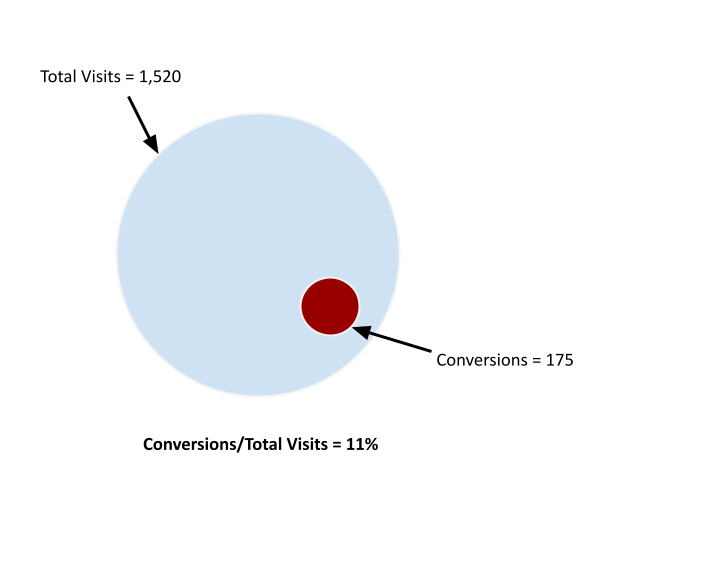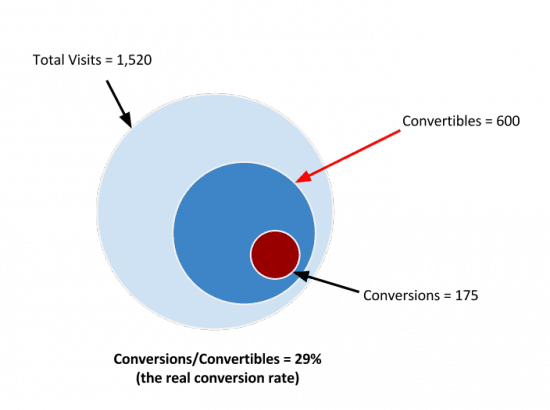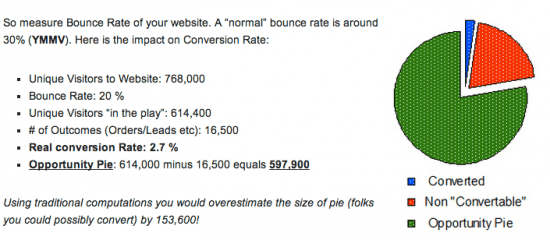How to use people-focused analytics to change how you measure search marketing effectiveness
Most marketers will know the volume of visitors generated by search, but are you using visitor quality to measure the effectiveness of search traffic (organic or paid)? If you are, conversion rate is a key measure effectiveness.
In this post I'll explain how to increase it without spending a penny more. It's not intended to be an unrealistic boast instead it's a technique that makes allocating marketing spend and identifying successful campaigns easier and more effective.
Why your Conversion Rate is lying to you
Most people would measure Conversion Rate for a paid search campaign (or organic search) like this:

However, this formula has one major flaw, it assumes that all visitors from this campaign have the potential to convert. The reality is that only a fraction of search traffic is convertible, so your real conversion rate is actually much higher than you thought.

There, you’ve increased your Conversion Rate without spending a penny more by simply eliminating the data that muddles the big picture. Was I making an unrealistic boast there? Maybe, but take a moment to consider the powerful implications of this scenario.
Before I continue to describe the technique we need to state several assumptions:
- Customers typically don’t go from being completely unaware of a need for a product to purchasing a product in a single session. This does happen for some products but for the majority it’s a process that occurs over multiple interactions.
- Conversion rate can be calculated using visits or visitors as denominator. I’m using visits here because:
- I want to emphasise the fact that a single visitor makes multiple visits and each visit is likely to have a different underlying reason.
- In paid search you are fundamentally paying per click and therefore per visit, so it makes sense to use that context.
The powerful implications of Convertibles vs Inconvertibles
Avinash Kaushik of Google has discussed the issue of "real" conversion rates, he talks about "opportunity pie and "not-convertibles" as this example shows:

If it’s true that only some visitors have potential to convert then all the rest would have no potential. In other words, they would never convert no matter how hard we tweak our incentives and calls to action. We have to ask...
- Just how many of search visitors are Inconvertibles? 20%? 40%? 50%? 80%? Do they come from paid or organic? And more importantly, how much of our budget (and expectations) is wasted on visitors whom we know will never convert?
- Why are some people Inconvertibles? If it’s true that they have no potential to convert then what is the reason behind their visit? Just what makes some visitors Convertibles and what makes others Inconvertibles? Is there a way we could actually identify them and segment our web analytics data accordingly?
How to use potential for Convertibility to make better decisions
Once the reality of mixed convertibility in search engine traffic sinks in you inevitably start asking different questions about your campaigns:
- If search traffic is indeed divided between Convertibles and Inconvertibles then minimising the Inconvertibles and maximising the Convertibles (particularly high potential ones as we’ll see later on) is likely to have the highest immediate impact on our conversion rate.
- If we can identify the Inconvertibles and Convertibles, break the Convertibles down further by proximity to conversion and find a practical way to segment our data accordingly, then our assessment of search campaigns would change drastically.
Assess Search Campaigns
- Question 1. How you might assess Search Campaigns without people-focused analysis?
This campaign has 1% conversion rate, we should scrap it or We should kill all the keywords that don’t convert well.
- Question 2. How you might assess Search Campaigns with people-focused analysis?
This campaign brings only 60% Convertibles of which 80% are Early Stage Convertibles. We know our average customer takes around 3 visits before they convert so we would not expect these visitors to convert in this visit.Based on this distribution of intentions, the Conversion Rate is unsurprisingly low. We would, however, expect them to download our pre-selling materials. What was the micro-conversion rate for that?
…45%. That’s huge!
Which then helps you ask smarter questions:
- Question 3. How can we keep the Inconvertibles we pay for at a minimum?
It’s driving our cost per conversion soaring. We know Early Stage Convertibles will likely behave differently to Late Convertibles. We should split our PPC campaigns by proximity to conversion and use the most appropriate landing pages, calls to actions and incentives based on that intent.We should also use micro-conversion rate for the Early Stage Convertibles as benchmark for success rather than conversion rate as we would not reasonably expect Early Stage Convertibles to convert during the same visit.
- Question 4. How much can we afford to pay for Early Stage Convertibles compared to Late Convertibles?
In the long run, does it benefit us to increase the budget for Early Stage Convertibles or Late Stage Convertibles knowing that the former are less likely to convert straight away?
Which then highlights the importance of tracking and measuring the relative worth of micro and macro conversions
- Question 5. But how much are Early Stage Convertibles worth to our business anyway if it’s unlikely that they convert right away?
- Question 6. Can we assign a monetary value to every pre-selling download?
- Question 7. How do we establish which of these micro conversions help guide Early Convertibles into becoming Late Convertibles?
If you accept that you are attracting visitors with different potential for conversion and that you can only reasonably expect certain behaviour from each segment, your SEM strategy and how you measure it, may change dramatically.
- Short term, it helps fix leaks in your marketing budget by forcing you to keep the Inconvertibles (and therefore the cost per conversion) at a minimum.
- Over time, it helps find the winning combination between landing pages, messaging and calls to action tailored to fit what visitors need to hear based on what purchase funnel stage they are at, not what you desperately want them to do regardless of their likelihood to convert.
- Long term, it forces you to think what mix of visitor types is most valuable for your business based on how they graduate from every stage in the purchase cycle.
Put this into practice
Any theory is only as good as its applicability in real life, that's what I'll cover in Part 2 of this blog post. I'll explain how to use keyword classification by intent and custom dimensions to create segments by convertibility in your data.
Does your traffic bring in both Convertibles and Inconvertibles? Can you identify ways to break your search traffic down by potential for convertibility and customer lifecycle stage? Do you target Early Stage Convertibles or Late Stage Convertibles? And more importantly, do you expect the same response from each segment? If yes, then why? Please leave a comment with your thoughts.

Thanks to
Carmen Mardiros for sharing her advice and opinions in this post. Carmen Mardiros is an entrepreneur and independent web analytics consultant with a mission to help tech companies use data to reduce friction in their conversion funnel. You can follow her on
Twitter or connect on
LinkedIn.





 Thanks to
Thanks to 


